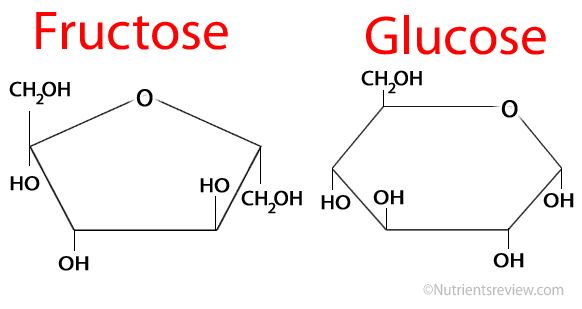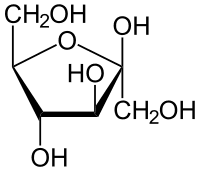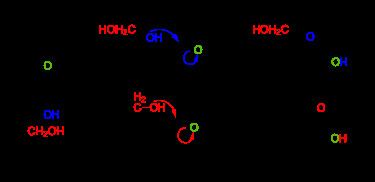Formula C6H12O6 IUPAC ID Fructose Soluble in Water | Molar mass 180.16 g/mol Melting point 103 °C Classification FODMAP | |
 | ||
Similar Table sugar, High‑fructose corn syrup, Water, Sugar, Starch | ||
Is high fructose corn syrup really that bad for you
Fructose, or fruit sugar, is a simple ketonic monosaccharide found in many plants, where it is often bonded to glucose to form the disaccharide sucrose. It is one of the three dietary monosaccharides, along with glucose and galactose, that are absorbed directly into the bloodstream during digestion. Fructose was discovered by French chemist Augustin-Pierre Dubrunfaut in 1847. The name "fructose" was coined in 1857 by the English chemist William Miller. Pure, dry fructose is a very sweet, white, odorless, crystalline solid and is the most water-soluble of all the sugars. Fructose is found in honey, tree and vine fruits, flowers, berries, and most root vegetables.
Contents
- Is high fructose corn syrup really that bad for you
- Honey high fructose corn syrup and the problems with nutrition research
- Chemical properties
- Fructose and fermentation
- Fructose and Maillard reaction
- Dehydration
- Sweetness of fructose
- Fructose solubility and crystallization
- Fructose hygroscopicity and humectancy
- Freezing point
- Fructose and starch functionality in food systems
- Fructose digestion and absorption in humans
- Capacity and rate of absorption
- Malabsorption
- Fructose metabolism
- Fructolysis
- Metabolism of fructose to DHAP and glyceraldehyde
- Synthesis of glycogen from DHAP and glyceraldehyde 3 phosphate
- Synthesis of triglyceride from DHAP and glyceraldehyde 3 phosphate
- Fructose synthesis
- Digestion
- Weight gain
- Cardiometabolic diseases
- Compared with sucrose
- Liver function
- Gout
- Glycemic index
- Appetite control
- References

Commercially, fructose is frequently derived from sugar cane, sugar beets, and corn. Crystalline fructose is the monosaccharide, dried, ground, and of high purity. High-fructose corn syrup (HFCS) is a mixture of glucose and fructose as monosaccharides. sucrose is a compound with one molecule of glucose covalently linked to one molecule of fructose. All forms of fructose, including fruits and juices, are commonly added to foods and drinks for palatability and taste enhancement, and for browning of some foods, such as baked goods.

About 240,000 tonnes of crystalline fructose are produced annually.
There is research indicating that excessive fructose consumption is a cause of insulin resistance, obesity, elevated LDL cholesterol and triglycerides, leading to metabolic syndrome, type 2 diabetes and cardiovascular disease. However, the European Food Safety Authority stated that fructose is preferable over sucrose and glucose in sugar-sweetened foods and beverages because of its lower effect on postprandial blood sugar levels, and also noted that "high intakes of fructose may lead to metabolic complications such as dyslipidaemia, insulin resistance and increased visceral adiposity". Further, the UK's Scientific Advisory Committee on Nutrition in 2015 disputed the claims of fructose causing metabolic disorders, stating that "there is insufficient evidence to demonstrate that fructose intake ... leads to adverse health outcomes independent of any effects related to its presence as a component of total and free sugars."

Honey high fructose corn syrup and the problems with nutrition research
Chemical properties

Fructose is a 6-carbon polyhydroxyketone. Crystalline fructose adopts a cyclic six-membered structure owing to the stability of its hemiketal and internal hydrogen-bonding. This form is formally called D-fructopyranose. In solution, fructose exists as an equilibrium mixture of 70% fructopyranose and about 22% fructofuranose, as well as small amounts of three other forms, including the acyclic structure.
Fructose and fermentation

Fructose may be anaerobically fermented by yeast or bacteria. Yeast enzymes convert sugar (glucose, or fructose) to ethanol and carbon dioxide. The carbon dioxide released during fermentation will remain dissolved in water, where it will reach equilibrium with carbonic acid, unless the fermentation chamber is left open to the air. The dissolved carbon dioxide and carbonic acid produce the carbonation in bottled fermented beverages.
Fructose and Maillard reaction
Fructose undergoes the Maillard reaction, non-enzymatic browning, with amino acids. Because fructose exists to a greater extent in the open-chain form than does glucose, the initial stages of the Maillard reaction occur more rapidly than with glucose. Therefore, fructose has potential to contribute to changes in food palatability, as well as other nutritional effects, such as excessive browning, volume and tenderness reduction during cake preparation, and formation of mutagenic compounds.
Dehydration
Fructose readily dehydrates to give hydroxymethylfurfural ("HMF"). This process, in the future, may become part of a low-cost, carbon-neutral system to produce replacements for petrol and diesel from plants.
Sweetness of fructose
The primary reason that fructose is used commercially in foods and beverages, besides its low cost, is its high relative sweetness. It is the sweetest of all naturally occurring Carbohydrates. The relative sweetness of fructose has been reported in the range of 1.2-1.8 times that of sucrose. However, it is the 6-membered ring form of fructose that is sweeter; the 5-membered ring form tastes about the same as usual table sugar. Warming fructose leads to formation of the 5-membered ring form. Therefore the relative sweetness decreases with increasing temperature. However it has been observed that the absolute sweetness of fructose is identical at 5°C as 50°C and thus the relative sweetness to sucrose is not due to anomeric distribution but a decrease in the absolute sweetness of sucrose at lower temperatures.
The sweetness of fructose is perceived earlier than that of sucrose or glucose, and the taste sensation reaches a peak (higher than that of sucrose) and diminishes more quickly than that of sucrose. Fructose can also enhance other flavors in the system.
Fructose exhibits a sweetness synergy effect when used in combination with other sweeteners. The relative sweetness of fructose blended with sucrose, aspartame, or saccharin is perceived to be greater than the sweetness calculated from individual components.
Fructose solubility and crystallization
Fructose has higher solubility than other sugars as well as other sugar alcohols. Fructose is, therefore, difficult to crystallize from an aqueous solution. Sugar mixes containing fructose, such as candies, are softer than those containing other sugars because of the greater solubility of fructose.
Fructose hygroscopicity and humectancy
Fructose is quicker to absorb moisture and slower to release it to the environment than sucrose, glucose, or other nutritive sweeteners. Fructose is an excellent humectant and retains moisture for a long period of time even at low relative humidity (RH). Therefore, fructose can contribute a more palatable texture, and longer shelf life to the food products in which it is used.
Freezing point
Fructose has a greater effect on freezing point depression than disaccharides or oligosaccharides, which may protect the integrity of cell walls of fruit by reducing ice crystal formation. However, this characteristic may be undesirable in soft-serve or hard-frozen dairy desserts.
Fructose and starch functionality in food systems
Fructose increases starch viscosity more rapidly and achieves a higher final viscosity than sucrose because fructose lowers the temperature required during gelatinizing of starch, causing a greater final viscosity.
Although some artificial sweeteners are not suitable for home-baking, many traditional recipes use fructose.
Fructose digestion and absorption in humans
Fructose exists in foods either as a monosaccharide (free fructose) or as a unit of a disaccharide (sucrose). Free fructose is absorbed directly by the intestine. When fructose is consumed in the form of sucrose, it is digested (broken down) and then absorbed as free fructose. As sucrose comes into contact with the membrane of the small intestine, the enzyme sucrase catalyzes the cleavage of sucrose to yield one glucose unit and one fructose unit, which are then each absorbed. After absorption, it enters the hepatic portal vein and is directed toward the liver.
The mechanism of fructose absorption in the small intestine is not completely understood. Some evidence suggests active transport, because fructose uptake has been shown to occur against a concentration gradient. However, the majority of research supports the claim that fructose absorption occurs on the mucosal membrane via facilitated transport involving GLUT5 transport proteins. Since the concentration of fructose is higher in the lumen, fructose is able to flow down a concentration gradient into the enterocytes, assisted by transport proteins. Fructose may be transported out of the enterocyte across the basolateral membrane by either GLUT2 or GLUT5, although the GLUT2 transporter has a greater capacity for transporting fructose, and, therefore, the majority of fructose is transported out of the enterocyte through GLUT2.
Capacity and rate of absorption
The absorption capacity for fructose in monosaccharide form ranges from less than 5 g to 50 g (per individual serving) and adapts with changes in dietary fructose intake. Studies show the greatest absorption rate occurs when glucose and fructose are administered in equal quantities. When fructose is ingested as part of the disaccharide sucrose, absorption capacity is much higher because fructose exists in a 1:1 ratio with glucose. It appears that the GLUT5 transfer rate may be saturated at low levels, and absorption is increased through joint absorption with glucose. One proposed mechanism for this phenomenon is a glucose-dependent cotransport of fructose. In addition, fructose transfer activity increases with dietary fructose intake. The presence of fructose in the lumen causes increased mRNA transcription of GLUT5, leading to increased transport proteins. High-fructose diets (>2.4 g/kg body wt) increase transport proteins within three days of intake.
Malabsorption
Several studies have measured the intestinal absorption of fructose using the hydrogen breath test. These studies indicate that fructose is not completely absorbed in the small intestine. When fructose is not absorbed in the small intestine, it is transported into the large intestine, where it is fermented by the colonic flora. Hydrogen is produced during the fermentation process and dissolves into the blood of the portal vein. This hydrogen is transported to the lungs, where it is exchanged across the lungs and is measurable by the hydrogen breath test. The colonic flora also produces carbon dioxide, short-chain fatty acids, organic acids, and trace gases in the presence of unabsorbed fructose. The presence of gases and organic acids in the large intestine causes gastrointestinal symptoms such as bloating, diarrhea, flatulence, and gastrointestial pain Exercise immediately after consumption can exacerbate these symptoms by decreasing transit time in the small intestine, resulting in a greater amount of fructose emptied into the large intestine.
Fructose metabolism
All three dietary monosaccharides are transported into the liver by the GLUT2 transporter. Fructose and galactose are phosphorylated in the liver by fructokinase (Km= 0.5 mM) and galactokinase (Km = 0.8 mM). By contrast, glucose tends to pass through the liver (Km of hepatic glucokinase = 10 mM) and can be metabolised anywhere in the body. Uptake of fructose by the liver is not regulated by insulin. However, insulin is capable of increasing the abundance and functional activity of GLUT5 in skeletal muscle cells.
Fructolysis
The initial catabolism of fructose is sometimes referred to as fructolysis, in analogy with glycolysis, the catabolism of glucose. In fructolysis, the enzyme fructokinase initially produces fructose 1-phosphate, which is split by aldolase B to produce the trioses dihydroxyacetone phosphate (DHAP) and glyceraldehyde [2]. Unlike glycolysis, in fructolysis the triose glyceraldehyde lacks a phosphate group. A third enzyme, triokinase, is therefore required to phosphorylate glyceraldehyde, producing glyceraldehyde 3-phosphate. The resulting trioses are identical to those obtained in glycolysis and can enter the gluconeogenic pathway for glucose or glycogen synthesis, or be further catabolized through the lower glycolytic pathway to pyruvate.
Metabolism of fructose to DHAP and glyceraldehyde
The first step in the metabolism of fructose is the phosphorylation of fructose to fructose 1-phosphate by fructokinase, thus trapping fructose for metabolism in the liver. Fructose 1-phosphate then undergoes hydrolysis by aldolase B to form DHAP and glyceraldehydes; DHAP can either be isomerized to glyceraldehyde 3-phosphate by triosephosphate isomerase or undergo reduction to glycerol 3-phosphate by glycerol 3-phosphate dehydrogenase. The glyceraldehyde produced may also be converted to glyceraldehyde 3-phosphate by glyceraldehyde kinase or further converted to glycerol 3-phosphate by glycerol 3-phosphate dehydrogenase. The metabolism of fructose at this point yields intermediates in the gluconeogenic pathway leading to glycogen synthesis as well as fatty acid and triglyceride synthesis.
Synthesis of glycogen from DHAP and glyceraldehyde 3-phosphate
The resultant glyceraldehyde formed by aldolase B then undergoes phosphorylation to glyceraldehyde 3-phosphate. Increased concentrations of DHAP and glyceraldehyde 3-phosphate in the liver drive the gluconeogenic pathway toward glucose and subsequent glycogen synthesis. It appears that fructose is a better substrate for glycogen synthesis than glucose and that glycogen replenishment takes precedence over triglyceride formation. Once liver glycogen is replenished, the intermediates of fructose metabolism are primarily directed toward triglyceride synthesis.
Synthesis of triglyceride from DHAP and glyceraldehyde 3-phosphate
Carbons from dietary fructose are found in both the free fatty acid and glycerol moieties of plasma triglycerides. High fructose consumption can lead to excess pyruvate production, causing a buildup of Krebs cycle intermediates. Accumulated citrate can be transported from the mitochondria into the cytosol of hepatocytes, converted to acetyl CoA by citrate lyase and directed toward fatty acid synthesis. In addition, DHAP can be converted to glycerol 3-phosphate, providing the glycerol backbone for the triglyceride molecule. Triglycerides are incorporated into very-low-Density lipoproteins (VLDL), which are released from the liver destined toward peripheral tissues for storage in both Fat and muscle cells.
Fructose synthesis
Humans are capable of synthesizing fructose from glucose via the polyol pathway. This pathway is used by the seminal vesicles to secrete fructose into semen where it is a major source of Energy for sperm.
Digestion
Fructose absorption occurs in the small intestine via the GLUT-5 (fructose only) transporter, and the GLUT2 transporter, for which it competes with glucose and galactose. Over-consumption of fructose, inhibition of GLUT2 by other phytochemicals, such as flavonoids, or other issues, may result in delivery of unabsorbed fructose into the large intestine, which will cause more water to be drawn into the large intestine through the process of osmosis causing diarrhea. In addition, the excessive fructose becomes a source of nutrients for the gut flora resulting in a higher production of short chain fatty acids, hydrogen, carbon dioxide and other gases due to fermentation. This increase of gas causes gastrointestinal side effects that mimic irritable bowel syndrome.
Weight gain
In a meta-analysis of clinical trials with controlled feeding — where test subjects were fed a fixed amount of energy rather than being allowed to choose the amount they ate — fructose was not an independent factor for weight gain; however, fructose consumption was associated with weight gain when the fructose provided excess calories.
Cardiometabolic diseases
Excess fructose consumption has been hypothesized to be a cause of insulin resistance, obesity, elevated LDL cholesterol and triglycerides, leading to metabolic syndrome. In preliminary research, fructose consumption was correlated with obesity. Fructose encourages visceral adipose tissue deposition in humans.
Studies indicate that there may be an increased risk of cardiovascular disease from a high intake of fructose. Studies have associated high fructose consumption with increased incidence of hypertension, both acutely and in the long term in subjects without a history of hypertension. The mechanistic link for this is thought to be the increased production of uric acid, a known predictor for hypertension. The elevation in uric acid is due to unregulated phosphorylation leading to depletion of ATP and subsequent ADP degradation to uric acid.
Another study in humans concluded that fructose and sucrose are metabolized similarly, whereas a different analysis "produced significantly higher fasting plasma triglyceride values than did the glucose diet in men" and "...if plasma triacylglycerols are a risk factor for cardiovascular disease, then diets high in fructose may be undesirable". A study in 2015 later confirmed this by showing that consuming beverages with high levels of high-fructose corn syrup caused heightened levels of LDL cholesterol, non-HDL cholesterol, apolipoprotein B, all of which are lipid/lipoproteins risk factors for cardiovascular disease.
In contrast to the above claims of fructose contributing to cardiometabolic diseases, an expert panel of the European Food Safety Authority concluded that fructose be preferred in food and beverage manufacturing to replace sucrose and glucose due to the lower effect of fructose on blood glucose levels following a meal.
Compared with sucrose
Fructose is often recommended for diabetics because it does not trigger the production of insulin by pancreatic β cells, probably because β cells have low levels of GLUT5, although the net effect for both diabetics and non-diabetics is debated. Fructose has a low glycemic index of 19 ± 2, compared with 100 for glucose and 68 ± 5 for sucrose. Fructose is also 73% sweeter than sucrose at room temperature, so diabetics can use less of it. Studies show that fructose consumed before a meal may even lessen the glycemic response of the meal. Fructose-sweetened food and beverage products cause less of a rise in blood glucose levels than do those manufactured with sucrose or glucose.
Liver function
Excessive fructose consumption may contribute to the development of non-alcoholic fatty liver disease.
Gout
A 2008 study found a risk of incident gout associated with high consumption of fructose or fructose-rich foods.
Glycemic index
Fructose has the lowest glycemic index (GI = 19) of all the natural sugars. In comparison, ordinary table sugar (sucrose, which is half fructose) has a GI of 65 and honey (usually about 50% fructose content) has a GI of 55.
Appetite control
Compared with consumption of high glucose beverages, drinking high-fructose beverages with meals results in lower circulating insulin and leptin levels, and higher ghrelin levels after the meal. Since leptin and insulin decrease appetite and ghrelin increases appetite, some researchers suspect that eating large amounts of fructose increases the likelihood of weight gain.
